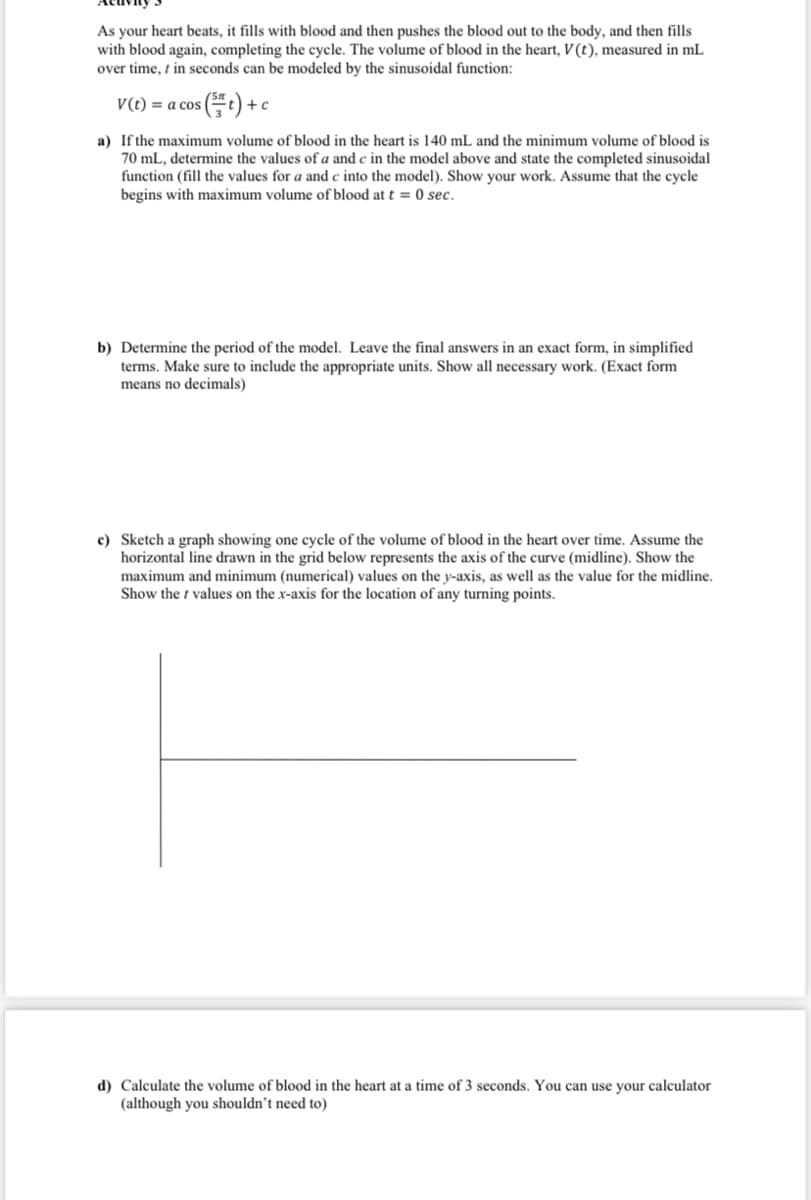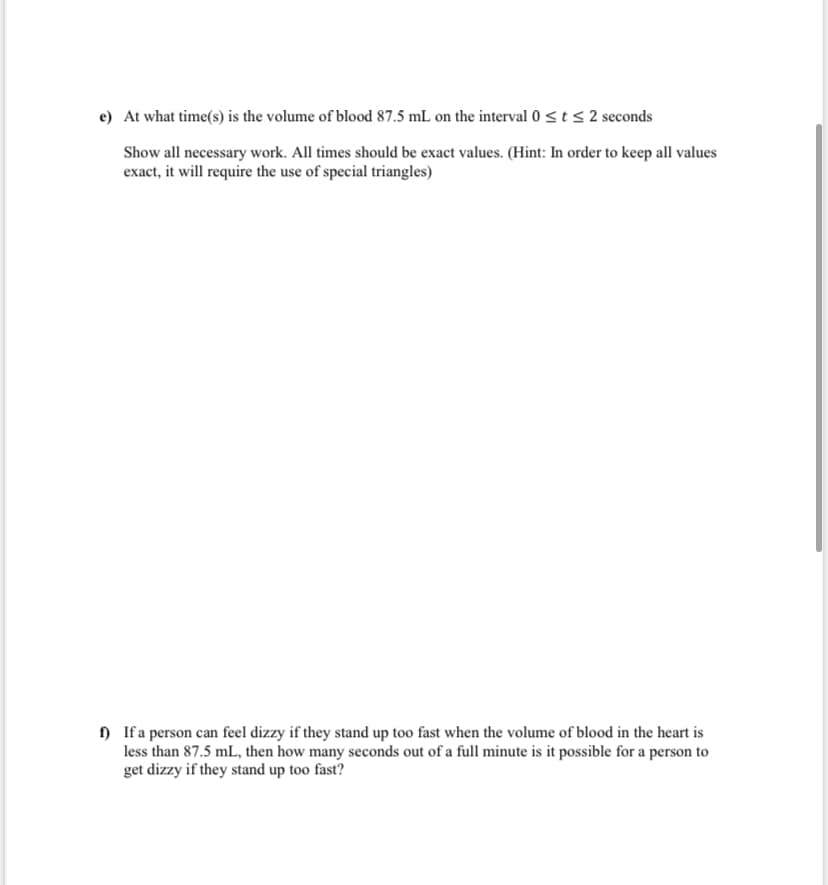Activity S As your heart beats, it fills with blood and then pushes the blood out to the body, and then fills with blood again, completing the cycle. The volume of blood in the heart, V(t), measured in mL over time, t in seconds can be modeled by the sinusoidal function: V(t)= a cos( s (Ft) + c a) If the maximum volume of blood in the heart is 140 mL and the minimum volume of blood is 70 mL, determine the values of a and c in the model above and state the completed sinusoidal function (fill the values for a and c into the model). Show your work. Assume that the cycle begins with maximum volume of blood at t= 0 sec. b) Determine the period of the model. Leave the final answers in an exact form, in simplified terms. Make sure to include the appropriate units. Show all necessary work. (Exact form means no decimals) c) Sketch a graph showing one cycle of the volume of blood in the heart over time. Assume the horizontal line drawn in the grid below represents the axis of the curve (midline). Show the maximum and minimum (numerical) values on the y-axis, as well as the value for the midline. Show the values on the x-axis for the location of any turning points.
Activity S As your heart beats, it fills with blood and then pushes the blood out to the body, and then fills with blood again, completing the cycle. The volume of blood in the heart, V(t), measured in mL over time, t in seconds can be modeled by the sinusoidal function: V(t)= a cos( s (Ft) + c a) If the maximum volume of blood in the heart is 140 mL and the minimum volume of blood is 70 mL, determine the values of a and c in the model above and state the completed sinusoidal function (fill the values for a and c into the model). Show your work. Assume that the cycle begins with maximum volume of blood at t= 0 sec. b) Determine the period of the model. Leave the final answers in an exact form, in simplified terms. Make sure to include the appropriate units. Show all necessary work. (Exact form means no decimals) c) Sketch a graph showing one cycle of the volume of blood in the heart over time. Assume the horizontal line drawn in the grid below represents the axis of the curve (midline). Show the maximum and minimum (numerical) values on the y-axis, as well as the value for the midline. Show the values on the x-axis for the location of any turning points.
Algebra for College Students
10th Edition
ISBN:9781285195780
Author:Jerome E. Kaufmann, Karen L. Schwitters
Publisher:Jerome E. Kaufmann, Karen L. Schwitters
Chapter13: Conic Sections
Section13.1: Circles
Problem 45PS
Related questions
Question

Transcribed Image Text:As your heart beats, it fills with blood and then pushes the blood out to the body, and then fills
with blood again, completing the cycle. The volume of blood in the heart, V(t), measured in ml
over time, t in seconds can be modeled by the sinusoidal function:
V(t)= a cos(
s(t) + c
a) If the maximum volume of blood in the heart is 140 mL and the minimum volume of blood is
70 mL, determine the values of a and c in the model above and state the completed sinusoidal
function (fill the values for a and c into the model). Show your work. Assume that the cycle
begins with maximum volume of blood at t = 0 sec.
b) Determine the period of the model. Leave the final answers in an exact form, in simplified
terms. Make sure to include the appropriate units. Show all necessary work. (Exact form
means no decimals)
c) Sketch a graph showing one cycle of the volume of blood in the heart over time. Assume the
horizontal line drawn in the grid below represents the axis of the curve (midline). Show the
maximum and minimum (numerical) values on the y-axis, as well as the value for the midline.
Show the values on the x-axis for the location of any turning points.
d) Calculate the volume of blood in the heart at a time of 3 seconds. You can use your calculator
(although you shouldn't need to)

Transcribed Image Text:e) At what time(s) is the volume of blood 87.5 mL on the interval 0 ≤ t ≤ 2 seconds
Show all necessary work. All times should be exact values. (Hint: In order to keep all values
exact, it will require the use of special triangles)
f) If a person can feel dizzy if they stand up too fast when the volume of blood in the heart is
less than 87.5 mL, then how many seconds out of a full minute is it possible for a person to
get dizzy if they stand up too fast?
Expert Solution
This question has been solved!
Explore an expertly crafted, step-by-step solution for a thorough understanding of key concepts.
Step by step
Solved in 6 steps with 6 images

Recommended textbooks for you

Algebra for College Students
Algebra
ISBN:
9781285195780
Author:
Jerome E. Kaufmann, Karen L. Schwitters
Publisher:
Cengage Learning

Algebra for College Students
Algebra
ISBN:
9781285195780
Author:
Jerome E. Kaufmann, Karen L. Schwitters
Publisher:
Cengage Learning